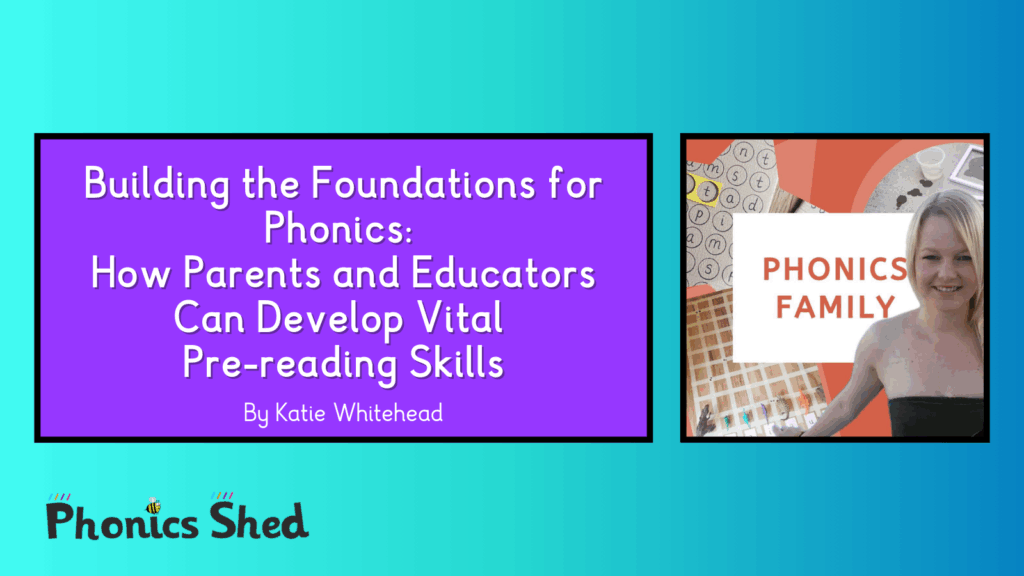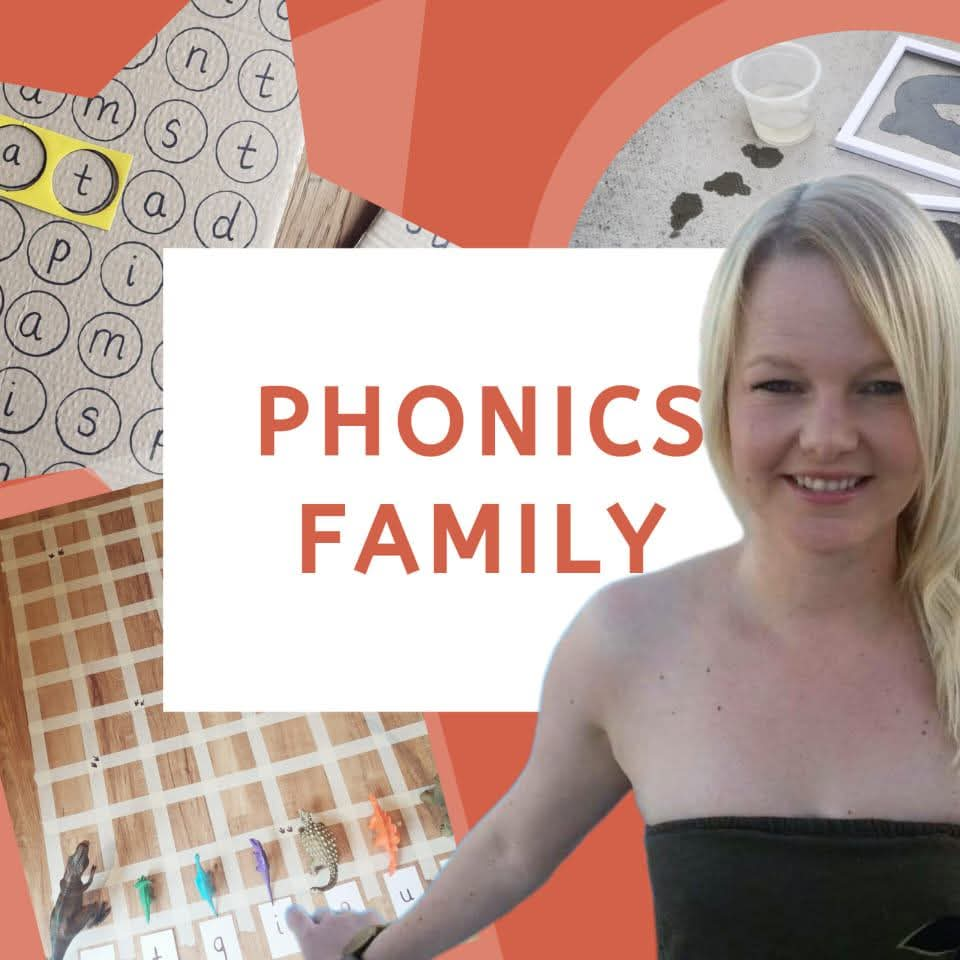Early Years educator, phonics specialist and author, Katie Whitehead (known to her followers as Phonics Family), shares her advice for developing vital pre-reading skills.
In the UK, conversations about school readiness are louder than ever. The Education Secretary, Bridget Phillipson, has declared it a national priority with ambitious targets. For example, 75% of five-year-olds being school-ready by Reception. The stakes, and the messaging, are only intensifying.
At the same time, social media amplifies the pressure with online voices suggesting two-year-olds must already be sounding out words and reading. The trend adds a heavy emotional load on parents seeking to do the ‘right thing’ and further adds to parental anxiety at a time where they may already be nervous about their child’s transition into school. Amid all the noise, it’s more important than ever to take a step back and remember that pre-reading skills are what truly prepare young learners for phonics and reading.
I am here to offer some practical advice and to put a few myths to bed (one in particular)! Preschoolers absolutely do not need to identify letters and their matching sounds or read words on a page. Instead, focusing on key speaking and listening skills will give children the best head start to their reading journey and all of these do not require expensive flashcards or resources. In fact, the greatest resource in your pre-reading arsenal is your voice!
Learning to read doesn’t actually start with phonics. It begins years earlier, through everyday interactions, playful activities and language-rich environments that build the foundations for literacy. Before children can recognise letters and blend sounds to read words, they need a secure foundation in pre-reading (the skills that make phonics even possible).
Parents and educators have a powerful role in developing these skills long before formal reading instruction begins. Below I will explore the core areas that prepare children for phonics success and how to foster pre-reading skills organically, none of which involve children recognising any letters or reciting the alphabet.
Developing Phonological Awareness
Phonological awareness is the ability to hear, identify and play with sound structures in spoken language, including: identifying words within a sentence, identifying syllables within words and rhyming. It’s all about tuning into larger units of sound, which children can later transfer this ability to identifying phonemes (the smallest unit of sound) within a word. This early sensitivity will help children later match letters to the right sound in print. You can build this by:
- Playing I Spy with initial sounds: “I spy something that begins with /m/”
- Clapping along to the beats in word: but-ter-fly, cat-ter-pil-lar
- Singing songs that emphasise repetition and patterns
Nursery Rhymes
Nursery rhymes are more than sweet traditions, they are language boot camps. Their repetitive rhythmic structure strengthens memory and helps children recognise patterns in language. Studies also suggest that if children know more rhymes by four years old, they tend to have stronger early reading skills later on. You could try:
- Reciting a few rhymes each day using expression and gestures
- Encouraging children to fill in the missing words in familiar rhymes
- Turning it into a movement game – jump every time a rhyme appears
Identifying Syllables
Breaking words into syllables is a critical bridge skill between hearing whole words and noticing individual sounds (phonemes). They help build a child’s internal ‘sound map’, making decoding less overwhelming later on. Fun ways to identify syllables include:
- Clapping, stomping or drumming for each syllable within a word
- Using blocks or counters to represent syllables
- Playing a game of ‘syllable sort’, grouping pictures by the number of syllables
Expanding Vocabulary
Studies have shown that vocabulary knowledge at school entry is a significant predictor of later reading comprehension and in turn is strongly related to overall academic achievement (Snow et al., 2007). A broad vocabulary is fuel for comprehension and motivation to read once children have the phonic ability to do so. You can grow a child’s vocabulary naturally by:
- Using rich, precise words in everyday conversation, something is not just ‘big’ but ‘enormous’ or ‘gigantic’.
- Introducing new words through themed play, e.g., when cooking, gardening or building
- Reading a variety of books and sharing stories pausing to discuss unfamiliar words
Crossing the Midline
This skill involves moving a hand, arm or leg across the centre of the body. This builds coordination between the left and right hemispheres of the brain, which is essential for tracking words across a page. Some play-based activities that support this skill might include:
- Drawing large-size figure-eights in the air with a finger or ribbon
- Throwing and catching a ball across the body
- Playing ‘Simon Says’ with cross-body movements
Memory Games
A strong working memory, which is a child’s ability to hold several things in their head, creates a strong foundation for later being able to hold sounds in their minds, recalling them and blending them together to read words. Learning phonics and the ability to read words is a mental juggling act. Children need to hold one sound whilst adding the next when they move onto reading words on a page. By developing working memory, you are essentially helping children give their brains a workout and develop the essential skill involved in reading. Try:
- Playing matching games with pictures or shapes, e.g., snap
- Recalling items from a tray after they have been covered
- Asking children about things they saw on a walk or trip
Visual Discrimination Skills
Noticing differences in shapes, sizes, orientations and patterns is essential for recognising letters later on, especially those that have a similar form like b/d and p/q. When children can easily distinguish such visual details, it can boost their reading accuracy once they start formal phonics instruction later on. Boost visual discrimination skills by:
- Sorting objects like buttons and leaves by subtle differences
- Playing ‘Spot the Difference’ games or puzzles
- Finding the same symbol or shape within a shared environment
Print Knowledge
Print knowledge is the ability to read and understand books and written words. It’s about having the awareness that print carries meaning, runs left to right and follows certain conventions. Familiarity with print makes phonics feel less like learning a secret code and more like joining a language club they already know. Here are some ways to nurture it:
- Pointing to words as you read aloud
- Letting children turn a page and ‘read’ using the illustrations
- Showing that writing is everywhere – in shops, signs and recipes
Sharing Stories
Storytelling develops comprehension, imagination, vocabulary and a love of language. All of which makes phonics more purposeful. Stories connect reading to joy, making the skill of reading worth later mastering. Here are a few tips for sharing stories effectively:
- Choosing books that match the child’s interests
- Pausing to ask questions and encouraging children to make predictions
- Providing children with the opportunity to retell the story in their own words or act it out.
Adults Modelling Reading
Children learn what they live. When they see adults reading for pleasure, information or relaxation, they absorb the message that reading is valuable. When reading is modelled as a natural part of life, children see phonics not as an academic hurdle but as a key to joining in. Some ways to model reading:
- Letting children catch you reading books, newspapers or recipes
- Talking aloud about what you are reading
- Creating shared reading moments where you both are reading your own book
Phonemic Awareness
Once children have been exposed to syllables, rhyme, stories and print within a language-rich environment, they can begin to be introduced to the more complex of the pre-reading skills. To master phonemic awareness is a subset of phonological awareness and is the most direct predictor of phonics success. It involves the ability to hear, isolate and manipulate the smallest unit of sounds (phonemes). Can children:
- Identify the initial sounds in words?
- Blend sounds to find a matching object? “Go and get your c/oa/t”
- Break up words into their individual sounds? “What three sounds make the word ‘sun’?
These pre-reading skills do not have to be developed during lessons. They are grown best in an environment full of conversation, play, music, movement and curiosity. Parents and educators can weave them into everyday routines – cooking, walking to nursery, playing in the park – and turn ordinary moments into rich literacy training grounds. By nurturing these areas, we give children the best possible start. The result isn’t just stronger phonics skills but confident, enthusiastic readers who see books as doors to adventure, learning and connection.


